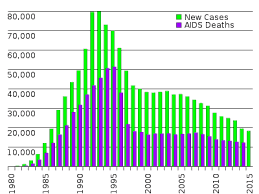On October 1, 1985, the United States faced a significant turning point in its response to the AIDS epidemic. This date marked the beginning of widespread testing for the human immunodeficiency virus (HIV), the virus that causes acquired immunodeficiency syndrome (AIDS). The introduction of HIV testing had far-reaching implications for public health, medical advancements, and the fight against stigma surrounding the disease. In the early 1980s, the emergence of a mysterious illness affecting primarily gay men raised concerns and confusion within the medical community and the public. As the disease continued to spread, it became clear that a new virus was responsible for compromising the immune system and leading to a range of infections and diseases. The decision to introduce widespread HIV testing on October 1, 1985, was a significant step towards understanding and combating the epidemic. Testing allowed individuals to know their HIV status, enabling them to make informed decisions about their health and take necessary precautions to prevent transmission to others. Testing also facilitated early diagnosis and access to treatment, improving the prognosis for individuals living with HIV. The introduction of HIV testing had a profound impact on public health. It enabled the tracking and monitoring of the disease's spread, providing crucial data for epidemiological studies and informing public health interventions. Testing allowed health officials to identify high-risk populations, target prevention efforts, and allocate resources effectively. Furthermore, HIV testing played a crucial role in the development of medical advancements and treatment options. As researchers gained a better understanding of the virus and its progression, testing became a crucial tool for evaluating the efficacy of new antiretroviral medications and other interventions. It allowed healthcare providers to monitor the viral load and immune function of individuals living with HIV, guiding treatment decisions and improving patient outcomes. The introduction of HIV testing on October 1, 1985, also had a significant impact on the societal response to AIDS. The availability of testing helped dispel misconceptions and reduce fear and stigma surrounding the disease. Testing normalized discussions about HIV and AIDS, encouraging individuals to seek information, support, and medical care without fear of judgment or discrimination. However, it is important to note that the introduction of HIV testing also raised ethical and societal challenges. The stigma associated with the disease led to discrimination and prejudice against individuals living with HIV. The fear of being labeled or ostracized prevented some individuals from seeking testing or disclosing their HIV status. Efforts to combat stigma and discrimination remain ongoing, and the importance of confidentiality and support services for individuals undergoing HIV testing cannot be overstated. The events of October 1, 1985, continue to shape the approach to HIV/AIDS prevention, treatment, and care today. Advances in testing technology have made HIV testing more accessible, accurate, and rapid. Testing is now recommended as part of routine healthcare for sexually active individuals, pregnant women, and those at high risk of contracting HIV. Additionally, the introduction of HIV testing paved the way for other prevention strategies, such as pre-exposure prophylaxis (PrEP) and post-exposure prophylaxis (PEP), which further reduce the risk of HIV transmission. Testing has become an integral part of comprehensive prevention and care efforts, helping to identify new infections and connect individuals to treatment and support services. The events of October 1, 1985, marked a significant milestone in the fight against HIV/AIDS in the United States. The introduction of widespread HIV testing revolutionized the approach to the disease, improving public health outcomes, advancing medical research, and challenging societal norms surrounding HIV/AIDS. The availability of testing has played a vital role in reducing new infections, improving treatment outcomes, and supporting individuals living with HIV. It serves as a reminder of the importance of early detection, access to care, and the ongoing commitment to fight against stigma and discrimination associated with HIV/AIDS.
1 Oct, 1985 U.S.A. AIDS
